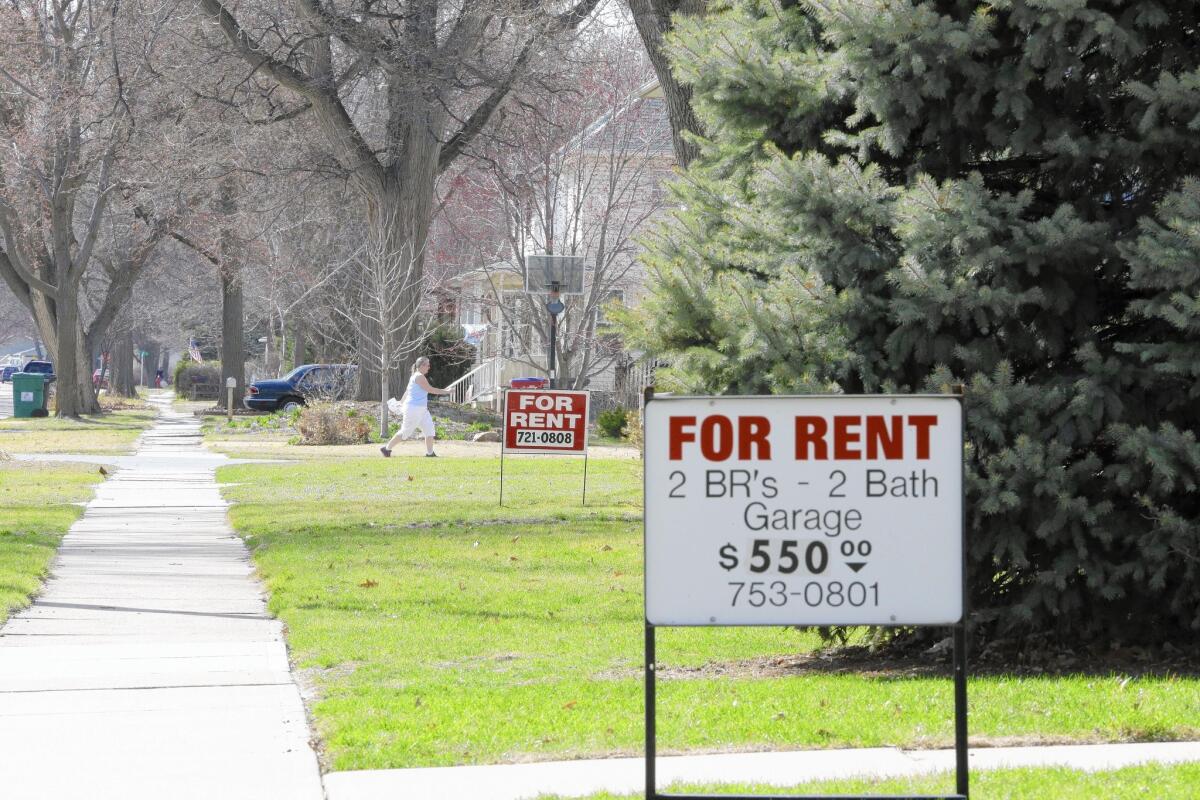Nebraska town’s anti-immigration rule stands, but furor persists

- Share via
Immigrants flocked to the meatpacking plants surrounding Fremont, Neb., during the last decade, nearly tripling the local Latino population and prompting some city leaders to propose an ordinance that would ban renting to those in the country illegally.
The lasting, public outrage that followed shocked many in the mild-mannered Midwestern outpost of 26,000 people about 30 miles northwest of Omaha.
“Conflict is uncomfortable — especially when it’s with people you work with or live near and have to see at the grocery store,” said Virginia Meyer, 27, a mother of two who eventually fought the ordinance.
This week, the U.S. Supreme Court decided not to review the ordinance adopted in 2010, a triumph for supporters who predicted more cities would follow their lead. Appeals courts in other states, however, have blocked similar ordinances, and cities may wonder whether it was worth the uproar.
“It would be reckless for any city to undertake an ordinance like this,” said Thomas Saenz, president and general counsel of the Mexican American Legal Defense and Education Fund, which sued to block it.
He said the ordinance, which took effect April 10, “shreds human relations.” It requires renters to purchase a $5 permit from the city and swear that they have permission to live in the United States legally.
The Supreme Court has often avoided addressing controversial immigration cases, leaving the matter to states and Congress to resolve.
The justices declined to address similar ordinances that lower courts struck down, seemingly setting up a conflict with the current case, said David Weber, a law professor at Creighton University in Omaha.
“They purposely ducked the question,” said Weber, who lives near Fremont and has witnessed how divisive the ordinance has become.
“We’re so homogenous that these fault lines are starting to develop,” and the question remains, he added, “How do these states, especially in the Midwest, that have been so homogenous for so much time, deal with these issues of assimilation and immigration that the border states have been dealing with for years?”
So far, 140 people have applied for the renters’ permit, less than half of what was expected, and none has had a questionable residency status, according to Fremont Police Chief Jeffrey Elliott.
Then-City Councilman Bob Warner, a construction superintendent, Democrat and lifelong Fremont resident, proposed the ordinance in 2008. Now 85 and retired from the council, Warner said he was responding to complaints from constituents about new immigrants straining local clinics, schools and police.
One woman told him about walking a few blocks to the local elementary school to sign her daughter up for kindergarten only to discover that she was one of only a few children in the class of 18 who spoke fluent English.
The swift pace of immigration concerned people. Residents worried Fremont would become another Schuyler, a town about 30 miles west that is known for its skyrocketing Latino population, more than 65% of the roughly 6,000 residents.
Fremont’s ordinance survived several challenges, including a repeal proposal in February that failed by a vote of 60% to 40%. Meyer campaigned for the repeal. She grew up in Minneapolis, where she lived and studied among Latino neighbors.
“I benefited a lot from being around that diversity, and I wanted my kids to really experience that and celebrate that instead of the tension I saw around Fremont,” she said.
Meyer travels to Schuyler occasionally for her job at a local agriculture and rural policy center. Instead of a town overrun by outsiders, she sees something else: a booming local economy.
“There’s restaurants, music playing downtown, young families, culture — that town feels alive. To reject all that’s going on in that community and say we don’t want Fremont to be like Schuyler is kind of shortsighted,” Meyer said.
The ACLU of Nebraska, along with MALDEF, sued to block the ordinance. They argued that the city should not be allowed to enforce federal immigration law, which opens the door for discrimination.
“Not all Latinos living in Fremont are undocumented,” said Alonzo Rivas, MALDEF’s Chicago-based regional counsel, noting that one of the plaintiffs in the group’s lawsuit is a legal resident — although his wife isn’t. “People who are here legally may be caught in this ordinance.”
Supporters of the ordinance enlisted Kansas Secretary of State Kris Kobach, a conservative Republican known for championing similar ordinances that ultimately failed in Hazleton, Pa., and Farmers Branch, Texas. Kobach claimed victory Tuesday, not just for Nebraska, but for states covered by the federal appeals court that has so far affirmed the ordinance, including Arkansas, Iowa, Minnesota, Missouri and the Dakotas. That court found that the ordinance did not discriminate against Latinos or interfere with federal immigration laws.
Now that the Supreme Court refused to hear the case, Kobach said, “all the cities there have to do is adopt the Fremont ordinance word for word and they will be on safe ground.”
But in Fremont, tensions linger, Meyer said. She knows ACLU and MALDEF lawyers are searching for signs of discrimination under the ordinance, and if they continue to pursue a lawsuit, it could be costly for her city.
“We’re not out of the woods yet,” she said. “It doesn’t feel like a victory.”
molly.hennessy-fiske@latimes.com
More to Read
Sign up for Essential California
The most important California stories and recommendations in your inbox every morning.
You may occasionally receive promotional content from the Los Angeles Times.














